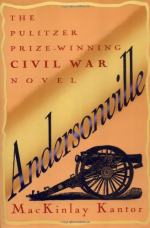At noon we are still straggling along without much attempt at soldierly order, over the rough, frozen hill-sides. It is yet bitterly cold, and men and horses draw themselves together, as if to expose as little surface as possible to the unkind elements. Not a word had been spoken by any one for hours.
The head of the column has just reached the top of the hill, and the rest of us are strung along for a quarter of a mile or so back.
Suddenly a few shots ring out upon the frosty air from the carbines of the advance. The general apathy is instantly, replaced by keen attention, and the boys instinctively range themselves into fours—the cavalry unit of action. The Major, who is riding about the middle of the first Company—I—dashes to the front. A glance seems to satisfy him, for he turns in his saddle and his voice rings out:
“Company I! Fours left into line!—March!!”
The Company swings around on the hill-top like a great, jointed toy snake. As the fours come into line on a trot, we see every man draw his saber and revolver. The Company raises a mighty cheer and dashes forward.
Company K presses forward to the ground Company I has just left, the fours sweep around into line, the sabers and revolvers come out spontaneously, the men cheer and the Company flings itself forward.
All this time we of Company L can see nothing except what the companies ahead of us are doing. We are wrought up to the highest pitch. As Company K clears its ground, we press forward eagerly. Now we go into line just as we raise the hill, and as my four comes around, I catch a hurried glimpse through a rift in the smoke of a line of butternut and gray clad men a hundred yards or so away. Their guns are at their faces, and I see the smoke and fire spurt from the muzzles. At the same instant our sabers and revolvers are drawn. We shout in a frenzy of excitement, and the horses spring forward as if shot from a bow.
I see nothing more until I reach the place where the Rebel line stood. Then I find it is gone. Looking beyond toward the bottom of the hill, I see the woods filled with Rebels, flying in disorder and our men yelling in pursuit. This is the portion of the line which Companies I and K struck. Here and there are men in butternut clothing, prone on the frozen ground, wounded and dying. I have just time to notice closely one middle-aged man lying almost under my horse’s feet. He has received a carbine bullet through his head and his blood colors a great space around him.
One brave man, riding a roan horse, attempts to rally his companions. He halts on a little knoll, wheels his horse to face us, and waves his hat to draw his companions to him. A tall, lank fellow in the next four to me—who goes by the nickname of “’Leven Yards”—aims his carbine at him, and, without checking his horse’s pace, fires. The heavy Sharpe’s bullet tears a gaping hole through the Rebel’s heart. He drops from his saddle, his life-blood runs down in little rills on either side of the knoll, and his riderless horse dashes away in a panic.




